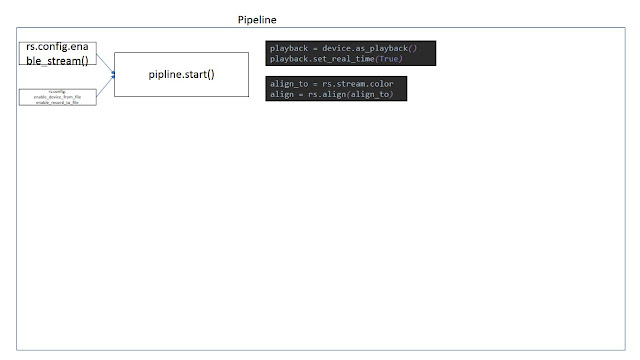Raspberry Pi + Realsense: Flask server
I would start first with the easy part, Flask
Flask is a micro framework to set up at server, app
and without setup like the whole Django file structure framework.
The good part is the variable they use is quite similar, because template of jinja2 and django is very similar
the code: https://github.com/soarwing52/Remote-Realsense/blob/master/flask_server.py
just as easy as this, a basic server is up
I can connect my phone, tablet to it
--------------------------------------------------------------------------------------------------------------------
I was looking for how to stream image from Pi to tablet.
the easiest way is html, and how to stream, with Flask is kind of the best example I can found
this is the example, I found with key word first found in one gist as mjpeg
because I was looking for socket possibility, and found some with SimpleHTTP library,
then the framework hit me, thanks to all the communities!
so I changed to look for stream image with flask.
what I give to this need to be image in bytes.
So I used opencv
imencode will return True/False then the image
-----------------------------------------------------------------------------------------------------------------------
@app.route('/auto/<in_text>')
def auto(in_text):
a.command = in_text
return in_text
with <variable> this will be input to the text when the GET method is sent. So all my commands are sent through this method
I have /cmd/<command> for camera control
/auto/<> for turn on and off the auto camera shots
/dis/<distance> for changing the distance per photo when using auto mode
basically with Regular Expression, I can handle all other requests from buttons, switch and spinbox
because I also built html user interface for IOS possibility
This thanks to
actually I found this video when I was basically done with the whole framework, while I use a really basic function and he is doing some fun projects
------------------------------------------------------------------------------------------------------------------------
and to put in variables using
{{ variable}}
and
and it can be used with if, else
or dictionatry
(https://www.tutorialspoint.com/flask/flask_templates.htm)
I was trying to also put the information to the html showing the current status of the system
but it cant be done with a lot of JavaScript work
So I just write it in the image with Opencv putText function
---------------------------------------------------------------------------------------------------------------
This is basically how a server is set up, the functions I used in this project.
The main hard side is how to design the structure behind, using threading and multiprocessing
Flask is a micro framework to set up at server, app
and without setup like the whole Django file structure framework.
The good part is the variable they use is quite similar, because template of jinja2 and django is very similar
the code: https://github.com/soarwing52/Remote-Realsense/blob/master/flask_server.py
The Hello World
from flask import Flask, render_template, Response
app = Flask(__name__)
@app.route('/')
def index():
return "Hello World"
if __name__ == '__main__':
try:
app.run('0.0.0.0')
except KeyboardInterrupt:
pass
finally:
pass
I can connect my phone, tablet to it
--------------------------------------------------------------------------------------------------------------------
The MJPEG
I was looking for how to stream image from Pi to tablet.
the easiest way is html, and how to stream, with Flask is kind of the best example I can found
def gen():
while True:
yield (b'--frame\r\n'
b'Content-Type: image/jpeg\r\n\r\n' + a.img + b'\r\n')
@app.route('/video_feed')
def video_feed():
return Response(gen(),
mimetype='multipart/x-mixed-replace; boundary=frame')
this is the example, I found with key word first found in one gist as mjpeg
because I was looking for socket possibility, and found some with SimpleHTTP library,
then the framework hit me, thanks to all the communities!
so I changed to look for stream image with flask.
what I give to this need to be image in bytes.
So I used opencv
cv2.imencode('.jpg', image)[1].tobytes()
imencode will return True/False then the image
-----------------------------------------------------------------------------------------------------------------------
Dynamic URL
so, to prevent writing a ton of @app.rout("/url") to set up all the GET method I want for my commands, this comes in handy@app.route('/auto/<in_text>')
def auto(in_text):
a.command = in_text
return in_text
with <variable> this will be input to the text when the GET method is sent. So all my commands are sent through this method
I have /cmd/<command> for camera control
/auto/<> for turn on and off the auto camera shots
/dis/<distance> for changing the distance per photo when using auto mode
basically with Regular Expression, I can handle all other requests from buttons, switch and spinbox
because I also built html user interface for IOS possibility
This thanks to
actually I found this video when I was basically done with the whole framework, while I use a really basic function and he is doing some fun projects
------------------------------------------------------------------------------------------------------------------------
Templates
The structure is create a folder "templates" and put all the html files in it, and it can use render_templetes functionand to put in variables using
{{ variable}}
and
@app.route('/')
def index():
return render_template(index.html, variable = "text or list")
and it can be used with if, else
{% if variable = 100 %}
{% endif %}
or dictionatry
{% for key, value in result.iteritems() %}
<tr>
<th> {{ key }} </th>
<td> {{ value }} </td>
</tr>
{% endfor %}
(https://www.tutorialspoint.com/flask/flask_templates.htm)
I was trying to also put the information to the html showing the current status of the system
but it cant be done with a lot of JavaScript work
So I just write it in the image with Opencv putText function
---------------------------------------------------------------------------------------------------------------
This is basically how a server is set up, the functions I used in this project.
The main hard side is how to design the structure behind, using threading and multiprocessing



Comments
Post a Comment